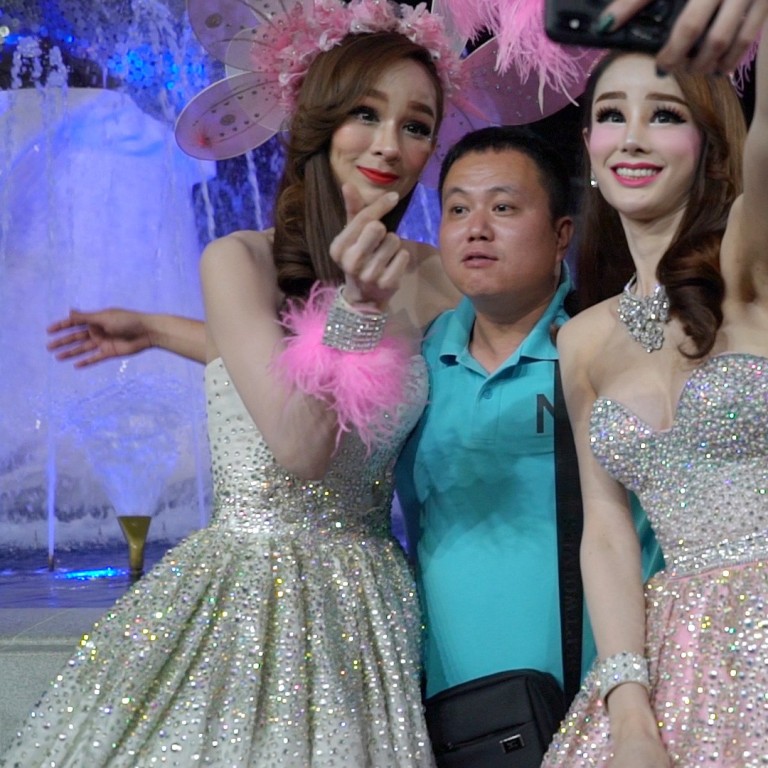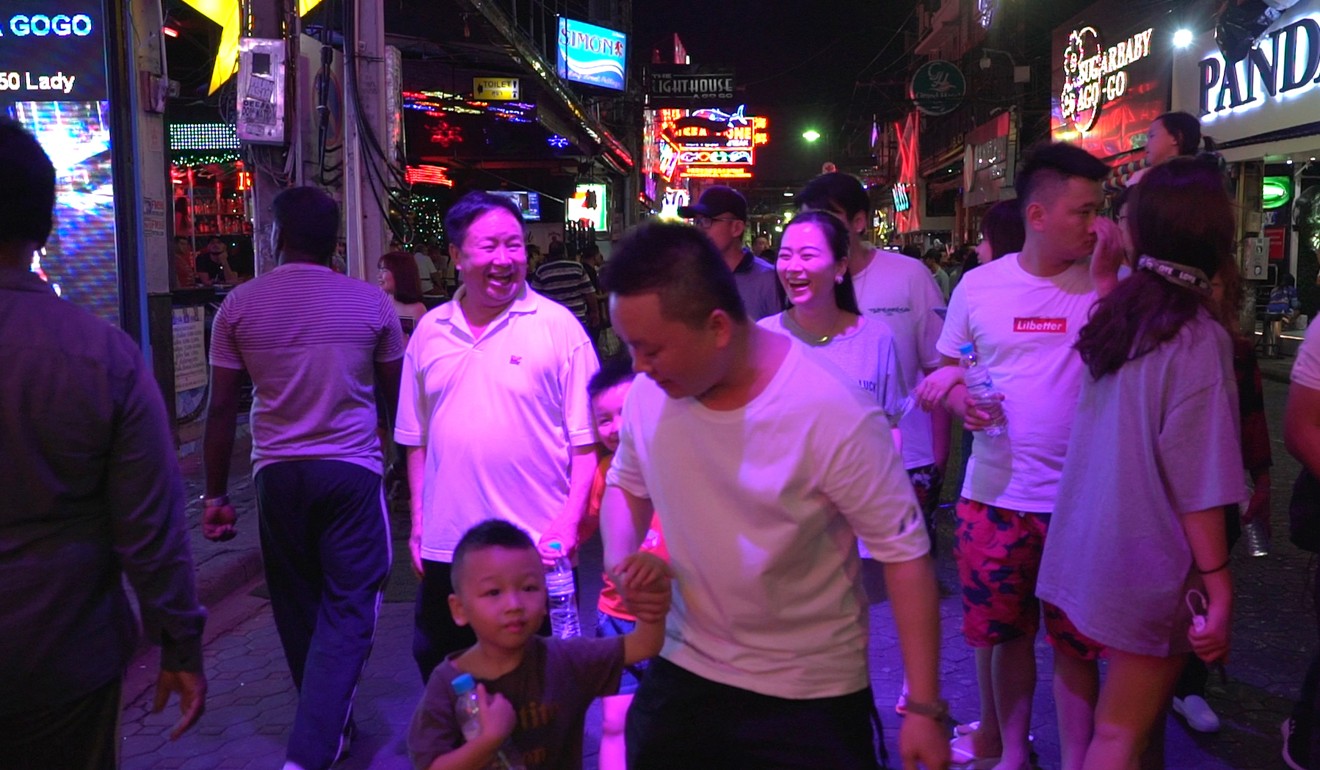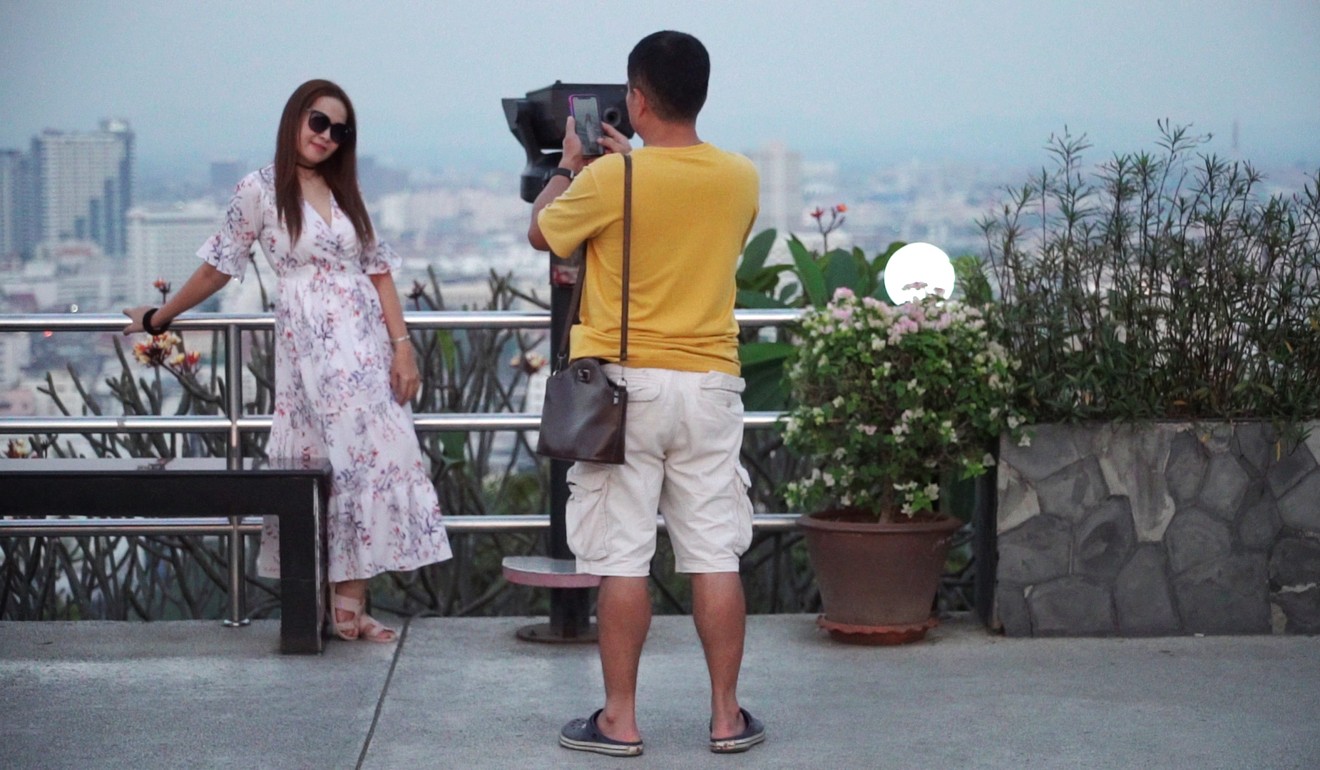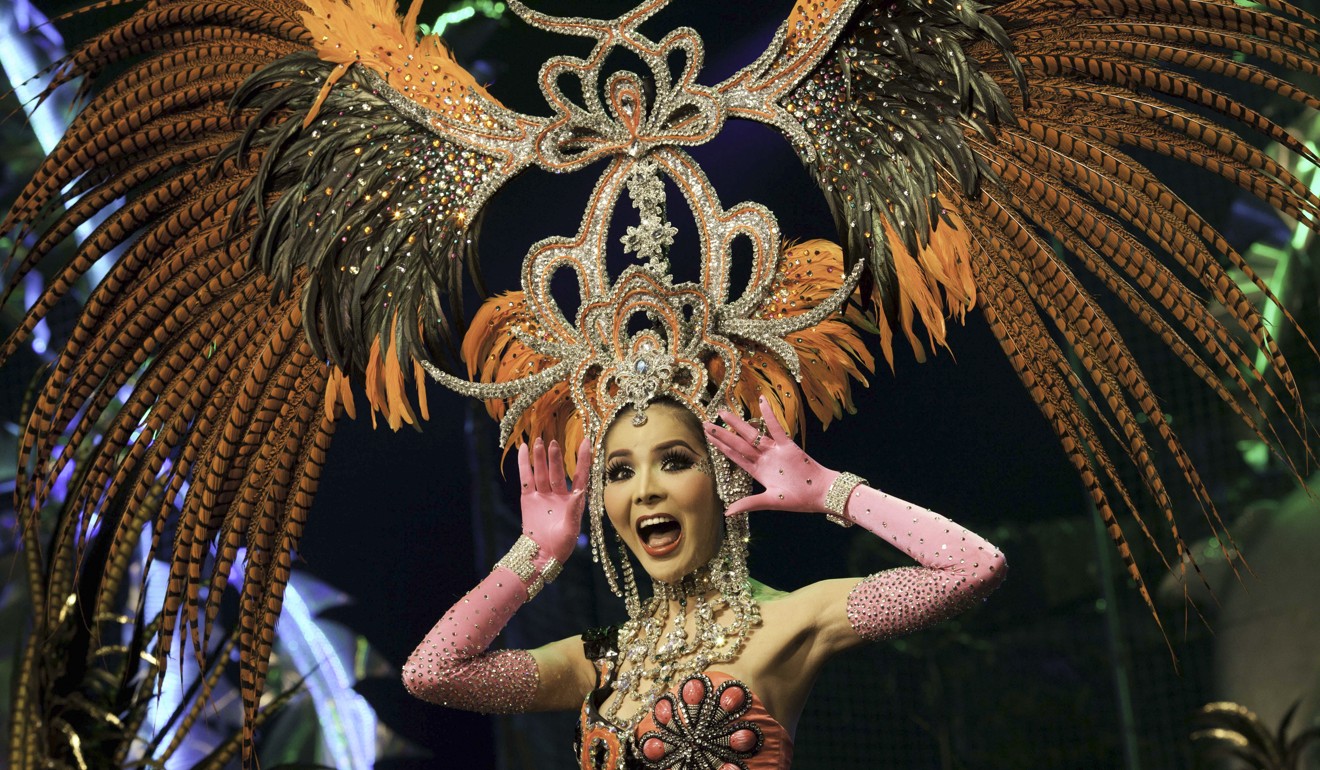
In Pattaya, a new breed of Chinese tourist emerges: meet the FITs
- Once known for decadence, the Thai city attracts a new generation of Chinese tourists: Free, Independent Travellers
- They are younger, wealthier, more adventurous – and unlikely to head to a factory to buy souvenirs they don’t need
The traffic hums with noisy trucks: Pattaya’s default form of public transport. Hop on, hop off wherever you like. Just 10 baht (US 30 cents) to hitch a ride. They’re called songtaew – or “two rows”, for the two rows of seats in the back. Thick streams of cable run overhead alongside the road, clustering like black rubbery cobwebs at every junction.
Palm trees separate the bitumen from the beach; piles of coconuts sell for 50 baht each; and beyond, an unending battalion of loungers and umbrellas.
Forget sex trainers, meet the real Russians of Thailand’s party town
These are the new breed of Chinese tourist: younger, wealthier, adventurous, independent. They have no interest in the rigidly organised group tours that deliver millions of Chinese to foreign shores.
“I like it here – everyone has a feeling of freedom,” says Jason, a 28-year-old from Taiyuan, in Shanxi province, who declined to give his last name. “The price is OK, everyone is friendly. My favourite thing is to go to the islands and at night, drink some beers, go dancing.
“The Thai people are very friendly. It’s like we are best friends.”

In keeping with Thailand’s status as the world’s No 1 return tourism destination, this is Jason’s second visit and he is certain he’ll be back: “Last time, it was just me, this time I’ve brought my wife; next time I will bring my parents.”
“I don’t have any concerns,” he says. “I think it’s safe here.”
It is his first visit and he has come alone.
“I like the culture,” he says. “A lot of Pattaya seems to be about sex but I don’t enjoy drinking or going to clubs. I mostly like going to the beach. The weather is good, the temperature is good.”
Both men are customers of Chavalit Daomukda, managing director of Pattaya Sea Adventure, the city’s first and most prominent company servicing the emerging group of Chinese “free, independent travellers”, or FIT in tourism industry parlance.
“I’ve been operating in Pattaya nearly 10 years,” says Chavalit, who estimates 75 per cent of his customers are mainland Chinese. The rest include ethnic Chinese from South Korea, Hong Kong and Taiwan.

“My business is to organise tours to the island, take my customers to do activities there – parachuting, sailboarding, jet skis, banana boat.”
Group tours have been a mainstay of the Chinese market in Pattaya but Chavalit says this is changing.
Listen to the Asia briefing podcast: Thai election analysis and exploring Pattaya
“They go to the beach, direct to the island, then come back. Next day, they go maybe to the crocodile farm.” he says. “But the new generation doesn’t want to do that. They want to organise the tour themselves, finding the information by themselves on the internet. Some people don’t plan anything but once they arrive at their hotel, they search the internet and decide.
“The new generation of tourists from China don’t want to go to buy something they don’t need from a big factory, like a jewellery factory.”

Despite Chavalit’s confidence that his business model is the way of the future, group tours still account for the overwhelming majority of mainland visitors to Pattaya. He says he gets between 200 and 350 Chinese FIT customers depending on the season, whereas the big tours bring in 2,000 to 3,000 Chinese visitors a day.
“In the long run, maybe 10 or 15 years, the numbers in big Chinese groups will go down,” he says, predicting more Chinese will come as independent travellers.
Thailand chases Chinese money, but at what cost?
Last July’s boat tragedy in Phuket affected Pattaya badly in the months that followed. According to the Australian-based Centre for Aviation, which compiles airline and airport data worldwide, there was a sharp drop in Chinese visitors to Thailand during August, September and October. Airlines cancelled flights. Low season got even lower.
“It affected business a lot,” Chavalit says. “I was getting around 150 tourists per day but after the crash, nobody was booking, no one was coming to Pattaya … they were afraid after the news from Phuket.
“The Chinese tourists were very worried about safety. The number of Chinese tourists in Pattaya went down around 60 to 70 per cent.”

The Phuket tragedy aside, there’s no doubt which way the trajectory curves. In 2009, 777,000 Chinese travelled to Thailand. Last year, that number had ballooned to 10.5 million out of a total of 38 million visitors to the country.
Why are middle-class Chinese moving their money abroad?
Government estimates suggest that Chinese visitors account for almost one-third of Thailand’s foreign tourism revenue: about US$20 billion. Pattaya has enjoyed the flow-on effects.
“Chinese tourists are coming back, it’s OK now for me,” Chavalit says. “In the last 10 years, the number of Chinese tourists in Pattaya has gone up. It’s doubled.”

The boom in Chinese arrivals over the past decade does not mean they have only recently discovered Thailand. On the contrary, 14 per cent of Thailand’s population is ethnically Chinese. That’s 10 million people, making the Chinese diaspora in Thailand the largest anywhere in the world.
The Chinese have been in Pattaya itself for more than 100 years, long before American soldiers showed up during the Vietnam war for rest and recreation, precipitating the city’s transformation from a sleepy fishing village into a resort town renowned for easy sex.
In the old community of Naklua, 3km from Pattaya’s main centre, this influence is on vivid display.
‘They only go to Chinese shops’: Cambodian backlash against mainland tourists
When the Chinese first arrived, they set up Pattaya’s first market in Naklua. Around the Lunar New Year, the front windows of Naklua’s boutiques are so full of red and gold cheongsam it is almost impossible to see within.
The Bodhi market – not the original market – is named after the thick-trunked Bodhi tree that occupies pride of place in the middle of the road outside.
There’s a bustling produce trade: mangoes stacked high, fresh seafood sold by the handful. Garlands of vibrant orange marigold are everywhere at this time of year in Thailand. But in Naklua, they are perhaps outnumbered by bright scarlet Chinese lanterns and glittering dragon insignias.

Tourism aside, Chinese investors appear to be taking renewed interest in Pattaya real estate. The Bang Lamung Land Authority, which oversees Pattaya, was recently instructed to begin collating data on Chinese nationals buying condos in the district – foreigners are not permitted to buy land in Thailand.
At the end of 2018, they found there were 5,876 Chinese owners – some presumably own more than one property. For a sense of scale, 8,137 properties in the district were sold in 2017. Last year, that rose to 9,639.
Chinese investment in the property market may be a relatively new trend, but the Chinese already account for a significant proportion of foreign ownership.
Can an app clean up the overseas image of Chinese tourists?
Ernest Novik, a Belarusian property agent operating in Pattaya for 14 years, estimates Chinese investors now account for 20 per cent of buyers. He describes a new showroom in Jomtien, a beach just south of Pattaya, where “everything is written in Chinese”.
“We are looking at Chinese financial expansion,” Novik says. “They invest money here but they don’t care about selling in Thailand, they sell it all in China. They don’t care about living here. The Chinese developer doesn’t care about local money. They’re looking for Chinese buyers in China.
“Chinese people buy property for investment. They never plan to stay here for a long time. Maybe they’ll come one time a year.”

Tiffany’s is Pattaya’s “original transvestite cabaret show”. It’s in its 44th year and is preparing to host Miss International Queen, the world’s biggest transgender beauty pageant, on March 8. It also appears to be bankrolled in large part by the droves of Chinese visitors queuing in its palatial foyer for one of the three daily shows.
“Tiffany’s has become a ‘word of mouth’ attraction among Chinese audiences so they make it a priority to visit us,” says Alisa Phanthusak Kunaplin, CEO of Tiffany’s parent company. “The Chinese tourists are families, old and young, newly married couples and from various backgrounds. They all love one common thing that Tiffany’s has to offer: 75 minutes of total entertainment, dazzle and happiness.”
What’s really behind Thailand’s hostility to Chinese tourists?
The show’s opening number is an ode to Pattaya, inviting guests to “escape into fantasy, indulge yourself in ecstasy”. The ensuing 75 minutes deliver an eye-popping mix of outlandish costumes, giant headdresses and a whole lot of sequins; an eclectic whirlwind channelling Buddhist iconography, Bollywood and Cirque du Soleil. And, of course, an obligatory appearance by Tina Turner.
The scenes in the foyer after the show are equally dizzying: the cast line up in full costume and adoring fans clamour for selfies.

“Most of the audience are from China, Korea, Japan, and Indonesia,” says Wirithorn “Bell” Norapatpimol, dolled up like a Disney princess. “I like to be up on stage performing in front of the audience. I can feel that my performance makes people happy from the smiles on their faces.”
For Ye Fang, it’s mission accomplished. She is visiting from Shenzhen with her two young daughters, aged five and nine, who both offer enthusiastic thumbs-up.
“We’ve just arrived in Pattaya – we’ve been at the beach and swimming at our hotel as well,” Ye says. “We have cold weather in China and here it’s very warm. Good people, good food.
“I’ve never seen a show like this before. There’s no show like this in China. I think it’s very special. Only in Thailand.” ■
